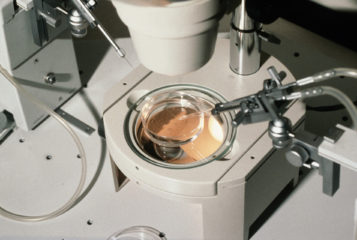A Danish woman has become the first in the world to give birth for a second time following an induced pluripotent stem cell (iPS cell) ovarian transplant. Experts have suggested that the technique, which is still considered as experimental, could be employed as a means of preserving the fertility of women facing medical treatment that could damage their ovaries.
Mrs Stinne Holm Bergholdt's fertility was restored using her own ovarian tissue, which was removed and frozen prior to cancer treatment in 2004. Once her treatment was completed, part of the tissue was thawed and re-implanted, allowing her to give birth to one daughter in 2007 and another in 2009. The birth of the second child more than four years after re-implantation has been heralded as a major breakthrough.
Details of Mrs Bergholdt's case were revealed last week in the online edition of Human Reproduction, the monthly journal of the European Society of Human Reproduction and Embryology (ESHRE).
This is not the first time that children have been born following an ovarian transplant, however, Mrs Bergholdt is the first to have given birth to two children from separate pregnancies. Describing the experience as a 'miracle', she said: 'The second time it was quite a surprise to find out I was pregnant since we hadn't been working on it - we thought we needed assistance like the first time'.
Mrs Bergholdt was diagnosed with a rare form of bone cancer aged 27, but before beginning chemotherapy had part of her right ovary removed and frozen in liquid nitrogen, a technique known as cryopreservation. A year later six thin strips of tissue were re-implanted onto her body, enabling her to produce eggs again normally. Mrs Bergholdt conceived her first child following a short course of hormones to stimulate egg production; the second child was conceived naturally.
Professor Anderson said the technique could be used to help maintain ovarian function for 'as long as 40 years'. He told the Daily Telegraph: 'She has seven more ovarian strips in the liquid nitrogen tank and may return, if she wishes so, to have more tissue transplanted in order to maintain her ovarian function once the current strips stop working.
The ability to store ovarian tissue raises the possibility of women using the procedure as a way to preserve their fertility. However, Dr Allan Pacey, a fertility expert at Sheffield University who was not linked to the study, said the invasive nature of the technique makes this unlikely: 'To suggest that a healthy woman would have two operations (to remove and re-implant the ovary) for the sake of social convenience, to have children later, is ludicrous'. Dr Pacey suggested that freezing the eggs themselves would be a much more suitable method of preserving fertility.
Sources and References
-
Ovarian transplant helps woman to be a mum
-
Mother has second child after ovary transplant
-
'Miracle' second baby for ovarian transplant woman
-
World first as woman left infertile with cancer has second 'miracle' baby
-
Woman 1st giving birth twice with ovary transplant






Leave a Reply
You must be logged in to post a comment.